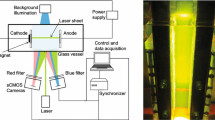Abstract
The influence of an electrochemically generated gas phase on the pressure drop in a three-dimensional electrode and an inert bed has been investigated. The electrode was composed of silvered glass particles, whereas the inert bed was composed of glass particles of the same diameter. During water electrolysis smaller gas bubbles are generated than by introducing gas into the system by means of a fluid distributor. Electrochemically generated bubbles with the liquid phase circulate upward through the electrode and the inert bed. The pressure drop for a monophase fluid was measured, as well as the change of pressure drop with time in the electrode and the inert bed for two-phase flow of fluid through an electrochemical cell. The steady and unsteady periods of the change of pressure drop have been discussed. Experiments were carried out at different electrolyte velocities and for different current densities. Higher electrolyte velocities cause an increase in the pressure drop in both beds. Also, increased current density causes an increase in gas evolution intensity at the electrode thereby increasing the pressure drop in both beds. A mathematical model describing the change of pressure drop with time has been proposed. The proposed model showed good agreement with experimental results as well as the results from the literature.
Similar content being viewed by others

References
L.S. Fan ‘Gas–Liquid–Solid Fluidization Engineering’ (Butterworths, Stoneham, MA, 1989).
U. Akman and A.K. Sunol, Chem. Eng. Sci. 49 (1994) 3555.
I. Iliuta, F.C. Thrion and O. Muntean, Chem. Eng. Sci. 51 (1996) 4987.
F. Larachi, M. Cassanello, A. Laurent, N. Midoux and G. Wild, Chem. Eng. Process. 36 (1997) 497.
D. Pletcher, I. Whyte, F.C. Walsh and J.P. Millington, J. Appl. Electrochem. 21 (1991) 667.
V.D. Stanković, G. Lazarević and A.A. Wragg, J. Appl. Electrochem. 25 (1995) 565.
V.D. Stanković and S. Stanković, J. Appl. Electrochem. 21 (1991) 124.
V.S. Stanković, R. Grujić and A.A. Wragg, J. Appl. Electrochem. 28 (1998) 321.
S.H. Chern, K. Muroyama and L.S. Fan, Chem. Eng. Sci. 38 (1983) 1167.
S.H. Chern, L.S. Fan and K. Muroyama, AIChE J. 30 (1984) 288.
L.S. Fan, K. Muroyama and S.H. Chern, Chem. Eng. J. 24 (1982) 143.
G.H. Song, F. Bavarian, L.S. Fan, R.D. Buttke and L.B. Peck, Can. J. Chem. Eng. 67 (1989) 265.
S.M. Serbula, PhD thesis (University of Belgrade, 2000).
S.M. Serbula and V.D. Stanković, J. Serb. Chem. Soc. 66 (2001) 53.
Author information
Authors and Affiliations
Corresponding author
Rights and permissions
About this article
Cite this article
Šerbula, S., Stanković, V. Influence of an electrochemically generated gas phase on pressure drop in a three-dimensional electrode and an inert bed. Journal of Applied Electrochemistry 32, 389–394 (2002). https://doi.org/10.1023/A:1016306728547
Issue Date:
DOI: https://doi.org/10.1023/A:1016306728547



